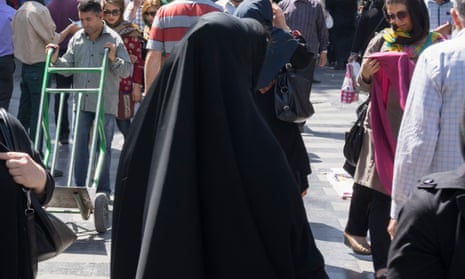Police in Iran’s capital have arrested 29 women accused of being “deceived” into joining protests against a law that makes wearing the hijab compulsory.
Women across the country have been protesting by climbing onto telecom boxes, taking off their headscarves and waving them aloft on sticks.
Although women in Iran have fought against the hijab for nearly four decades, the new wave of protests has grabbed more attention and sparked a debate rarely seen before over personal freedoms.
One recent image taken from Mashhad shows a religious woman, in full chador, standing on a telecoms box holding up a headscarf, in solidarity with women who - unlike her - don’t want to wear it.
Tehran police said on Thursday that the campaign had been instigated from outside Iran through illegal satellite channels. “Following calls by satellite channels under a campaign called White Wednesdays, 29 of those who had been deceived to remove their hijab have been arrested by the police,” the semi-official Tasnim news, which is affiliated to the elite Revolutionary Guards, reported on Thursday.
The reformist Shargh newspaper covered the protestsunder the headline “Reactions to the removal of headscarves in the streets”. Such discussions have rarely reached national newspapers, which operate under heavy censorship, but comments by judicial officials allowed Shargh to write about the matter.
Soheila Jolodarzadeh, a female member of the Iranian parliament, said the protests were the result of longstanding restrictions. “They’re happening because of our wrong approach,” she said, according to the semi-official Ilna news agency. “We imposed restrictions on women and put them under unnecessary restrains. This is why ... girls of Enghelab Street are putting their headscarves on a stick.”
انتخاب کرده چادری باشد و برای حق انتخاب بقیه زنان این سرزمین بیرق برافراشته. زیبایی دیگر چه میتواند باشد؟! #دختران_خیابان_انقلاب pic.twitter.com/bzzI0MX7js
— nahid molavi (@NahidMolavi) January 31, 2018
Iran’s prosecutor general, Mohammad Jafar Montazeri, described the protests on Wednesday as “childish”, “emotionally charged” and instigated “from outside the country”.
Masih Alinejad, a US-based journalist and activist, started the White Wednesdays campaign in May 2017, encouraging women to wear white headscarves or take them off in protest at the rules.
“The Iranian police announced in 2014 that they’ve warned, arrested or sent to court nearly 3.6 million women because of having bad hijab, so these arrests are not new, if people are protesting it’s exactly because of such a crackdown,” she told the Guardian.
Iranian officials have accused her of receiving money from foreign governments to fund her two separate anti-compulsory hijab campaigns – the first one is My Stealthy Freedom. Alinejad denied it, saying that although she works for the US government-funded Voice Of America service, she has received no funds for either of her campaigns.
